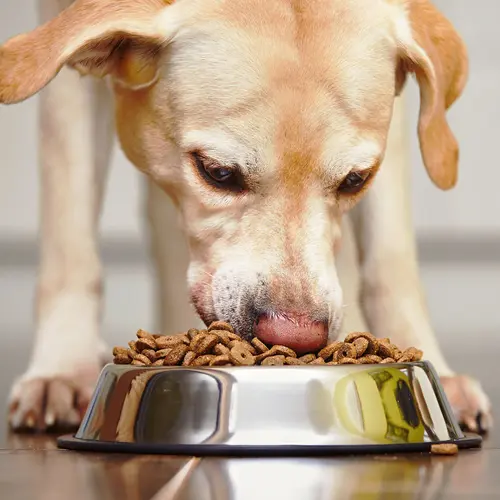In some ways, the labels on the food you eat and the food your dog eats aren't so different.
Some of the words on the packaging are intended to make the food sound appealing. Other information tells you how nutritious the food is. So how can you tell what is what and pick the right food for your pooch?
Look for the AAFCO information. "The fastest way to know whether foods meet the nutritional needs of whatever you want to feed it to -- a puppy or adult dog -- is to look at the AAFCO statement," says Rebecca Remillard, PhD, DVM, a pet nutritionist at North Carolina State University.
AAFCO stands for the Association of American Feed Control Officials.
The AAFCO statement tells you whether the food is "complete and balanced." That means you can use it as your pet's main food supply day after day.
Another phrase you might see is that a food is for "supplemental and intermittent use." That means you should give it only as a treat. These foods should make up no more than about 10% of your dog's daily calories, Remillard says.
Check if the food is intended for puppies, adults, or all life stages. If you have a "10-year-old couch-potato dog," a food for puppies is going to provide too many calories, she says.
Buying Food for Your Dog
Follow these tips when you're looking for dog food:
Avoid shopping by your tastes. These days, many people are turning away from starchy vegetables and avoiding wheat. Remillard sees plenty of pet owners who don't want ingredients like corn and wheat in their dog's food, either. "The word clients may use is 'I don't want a lot of fillers,'" she says.
But these grains aren't harmful in your dog's diet. And these ingredients may even be helpful in managing your dog's weight. Such grains are carbohydrates, and they can be a lower-calorie ingredient in food than fat.
Know the lingo. Certain words on a dog food label may not be as important to your dog's health as you might think:
- Premium. This has no official definition, says Cailin Heinze, VMD, an assistant professor of nutrition at Tufts University Cummings School of Veterinary Medicine. It means nothing in terms of quality or nutrition. The same goes for "super premium." Heinze has received consulting fees from several pet-food companies.
- Byproducts. A byproduct is part of an animal or plant that wasn't a food maker's original focus, Remillard says. Animal byproducts might be organs like liver, lungs, heart, or kidneys. These parts are very nutritious, and in the wild, dogs eat them first, Remillard says.
- Natural. This generally means no artificial colors, flavors, or preservatives.But the word "natural" doesn't say anything about a food's quality or nutritional value.
Avoid being swayed by ingredients in small amounts. Some dog food makers put in small amounts of healthy-sounding ingredients just so they'll look good on the label. If you see vegetables included after salt or vitamin/mineral supplements in the ingredient list, they're "probably not in any amounts that are useful," Heinze says. That's because ingredients are listed by weight, and makers don't put much salt or vitamin/mineral supplements into food compared to other ingredients.
Be careful when comparing foods. Another part of a dog food label is the guaranteed analysis. This tells you how much of the food is protein or fat at a minimum, and how much may be fiber and moisture.
Comparing the nutrition in canned and dry foods isn't easy, Heinze says, and it's not something the average person can do at the store. That's because:
- Water -- in other words, moisture -- accounts for a much higher percentage of a canned food's weight (roughly 70% to 80%, compared to about 10% for dry food).
- Meat is mostly water, not protein.
- Levels of nutrients such as protein and fat are usually lower in percentage on the label of canned food due to the water. But they're often higher in a dog's diet on a calorie basis compared to similar dry foods.
- Comparing the nutrients in canned and dry foods is possible, but it requires some math, which even some veterinary students have trouble doing the first few times, Heinze says.
Get good advice. If you don't know which of the hundreds of pet foods on the shelf are best for your dog, ask your veterinarian, Remillard says. Your vet can take into account your pet's age, health, and other factors when making a suggestion.

